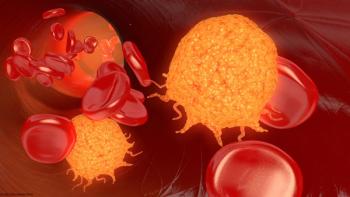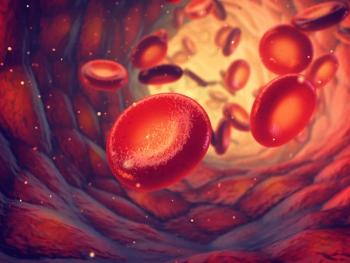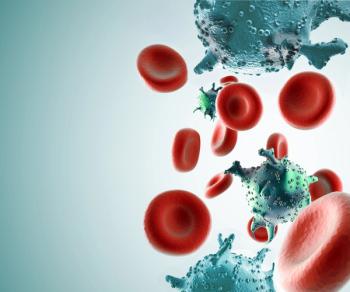
Radiotherapy Plus Sintilimab and Chemotherapy Improves pCR in Rectal Cancer
Short-course radiotherapy combined with sintilimab plus oxaliplatin-capecitabine yielded a pCR rate of 59.2% vs 32.7% with the control arm in locally advanced rectal cancer.
Short-course radiotherapy with sintilimab and capecitabine-oxaliplatin elicited an increased pathologic complete response (pCR) rate and a tolerable safety profile in the total neoadjuvant treatment of patients with locally advanced rectal cancer, according to results from the phase 2 SPRING-01 trial (ChiCTR2100052288) published in The Lancet Oncology.
In the intention-to-treat analysis, the pCR rate was 59.2% (95% CI, 45.4%-72.9%) with sintilimab plus capecitabine-oxaliplatin vs 32.7% (95% CI, 19.5%-45.8%) with capecitabine-oxaliplatin alone (OR, 3.0; 95% CI, 1.3-6.8; P = .0093), with a difference of 27% (95% CI, 8%-46%; P = .015). The sintilimab group also demonstrated improved CRs (OR, 3.2; 95% CI, 1.4-7.5; P = .0085) and major pathologic responses (OR, 3.1; 95% CI, 1.3-7.3; P = .013).
The sintilimab group showed favorable differences in the group of patients with a tumor distance more than 5 cm from anal verge (OR, 10.6; 95% CI, 3.1-35.8; P = .0002), clinical stage III disease (OR, 3.9; 95% CI, 1.6-9.5; P = .0031), clinical tumor stage T2 to T3 (OR, 3.6; 95% CI, 1.2-10.4; P = .018), clinical nodal stage N+ (OR, 3.9; 95% CI, 1.6-9.5; P = .0031), and positive extramural vascular invasion (OR, 4.6; 95% CI, 1.7-12.8; P = .0031).
The only groups who showed rate differences in favor of capecitabine-oxaliplatin alone were those with a tumor distance of 5 cm or less from the anal verge (OR, 0.6; 95% CI, 0.2-2.1; P = .40), clinical stage II disease (OR, 0.5; 95% CI, 0.1-5.2; P = .56), and clinical nodal stage N0 (OR, 0.5; 95% CI, 0.1-5.2; P = .56).
Of patients with clinically positive lymph nodes at baseline, 90% (95% CI, 80%-99%) in the sintilimab group and 82% (95% CI, 70%-94%) in the capecitabine-oxaliplatin alone group had pathologic staging assessed after neoadjuvant preoperative therapy N0 status after surgery.
Additionally, 100% of patients underwent laparoscopic surgery, and R0 resection rates did not differ significantly between groups. Postoperative complications were observed in 24% (95% CI, 12%-37%) of the sintilimab group and 11% (95% CI, 2%-21%) of the capecitabine-oxaliplatin alone group; this was not a significant difference. The most common complications were hypoalbuminemia (11% vs 7%, respectively), and no complications of grade 3 or higher or 60-day mortality were reported.
“Short-course radiotherapy followed by sintilimab plus capecitabine-oxaliplatin as total neoadjuvant therapy significantly improved pCR rates without compromising surgical safety in patients with locally advanced rectal cancer,” wrote corresponding study author Feng Tian, MD, of the Department of Gastrointestinal Surgery at Shandong Provincial Hospital, affiliated with Shandong First Medical University, in Jinan, China, and coauthors in the paper. “These findings suggest that this approach might offer a promising neoadjuvant option and warrant further investigation in larger, multicenter trials.”
SPRING-01 enrolled a total of 98 patients who were randomly assigned 1:1 to either sintilimab plus capecitabine-oxaliplatin (n = 49) or capecitabine-oxaliplatin alone (n = 49). All patients received short-course radiotherapy in the form of 5 Gy in 5 fractions; in the sintilimab group, patients received 6 cycles of 200 mg/m2 of intravenous sintilimab given on day 1 of each 3-week cycle and then 130 mg/m2 of intravenous oxaliplatin over 2 hours on day 1 and 1000 mg/m2 of oral capecitabine twice daily on days 1 to 14 of each 3-week cycle starting 1 week later. In the capecitabine-oxaliplatin group, the dosage was the same.
Eligible patients were aged of 18 to 85 years, with histological confirmation of newly diagnosed, treatment-naive primary rectal adenocarcinoma; the tumor’s inferior margin located 15 cm or less from the anal verge; and an ECOG performance status of 0 or 1.
The trial’s primary end point was the pCR rate using the modified Ryan scheme for tumor regression grade. Secondary end points included the CR rate, the major pCR, the R0 resection rate, surgical complications, and treatment-related adverse effects (TRAEs).
Regarding safety, TRAEs during neoadjuvant therapy occurred in 92% of the sintilimab group and 90% of the capecitabine-oxaliplatin alone group and grade 3 or higher TRAEs occurred in 33% and 35%, respectively. The most common TRAEs of grades 1 and 2 were thrombocytopenia (24% and 31%, respectively), leukopenia (35% and 47%), and anemia (53% and 65%); the most common grade 3 TRAEs were thrombocytopenia (12% and 22%), fever (6% and 4%), and leukopenia (4% and 6%); the only grade 4 TRAE was 1 case of pneumonia in the sintilimab group; and the only grade 5 TRAE was 1 case of ileus in the capecitabine-oxaliplatin group.
Reference
Tian F, Dai H, Sha D, et al. Total neoadjuvant treatment with short-course radiotherapy followed by sintilimab plus capecitabine–oxaliplatin versus short-course radiotherapy followed by capecitabine–oxaliplatin in patients with locally advanced rectal cancer (SPRING-01): a single-centre, open-label, phase 2, randomised controlled trial. Lancet Oncol. Published online July 8, 2025. doi:10.1016/S1470-2045(25)00286-4
Newsletter
Stay up to date on recent advances in the multidisciplinary approach to cancer.

















































































